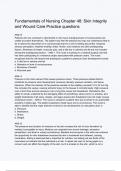Exam (elaborations)
Fundamentals of Nursing Chapter 48_ Skin Integrity and Wound Care Practice questions (
- Course
- Population & Wildlife Post
- Institution
- Population & Wildlife Post
Fundamentals of Nursing Chapter 48_ Skin Integrity and Wound Care Practice questions (
[Show more]




